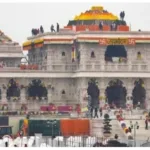The magnificent Ram Lalla Temple in Ayodhya is a well- crafted , well-designed, scientifically constructed and enginnering marvel projection of Indian traditional heritage. It was designed by famous architect Chandrakant B Sompura, with the help of his son Ashish, and incorporated his vision, which he underscored 30 years back.
Situated on 2.7 acres of land in the temple town, the temple is 161 feet tall, 235 feet wide, and boasts a total length of 360 feet. It is built on one of the two distinguishing temple-building styles from ancient India – Nagara – following all the Vedic rituals with an amalgamation of modern technology.
Features of the temple
The built-up area of the temple is nearly 57,000 square feet and stands as a three-floor structure. The height of the temple is approximately 70% of that of the Qutab Minar.
It based on a raised plinth, with the most sacred part of the temple called ‘garbha griha’ or the sanctum sanctorum, towered over by the tallest shikhara or the mountain peak on the third floor. A total of five such shikharas are corresponding the five mandapas. Additionally, the temple boasts 300 pillars distributed across the mandapas, and completed by the installation of 44 teak doors.
Almost two lakh bricks ,each inscribed with Lord Ram’s name in various languages and collected over 30 years across from the country are being incorporated into the temple.
The interiors of the sanctum sanctorum were decorated using Makrana marble, the same stone used to build the Taj Mahal.
No steel or iron was used
During the Gupta Period, from where the Nagara style emerged, the use of iron or steel was not prevalent in the construction of temples. The life span of iron is roughly 80-90 years. The temple is built using granite, sandstone, and marble with a lock and key mechanism, which gives a lifespan of up to 1,000 years. Interestingly, no cement or mortar has also been used in its construction.
Intially, the area underwent excavation to a depth of 15 metres, followed by the placement 47 layers of engineered soil to laid to a solid foundation base. Subsequently, a 1.5-metre thick M-35 grade concrete raft was laid, and a 6.3-metre thick plinth of solid granite stone was placed on top to make it sturdy.
Science juxtaposing tradition
Few top Indian scientists have contributed to making the iconic Ram Temple. ISRO technologies have also been used in the construction. Pradeep Kumar Ramancharla, the director of the Central Building Research Institute (CBRI), has been actively associated with the project.
A special ‘Surya Tilak’ mirror, a lens-based apparatus, was designed by a team of scientists from CBRI and the Indian Institute of Astrophysics (IIA). It will be used for a ceremonial anointment of Lord Ram on every Ram Navami day at noon with the sunlight on the idol’s forehead.







